The World Intellectual Property Organisation (WIPO) recently
published a report: WIPO Technology Trends, Future of
Transportation. The report provides a detailed review of
technology trends across a range of transportation sectors, based
upon a range of data sources (including patent filings). I provide
my own review of the data below, with a focus on air transportation
(e.g. airplanes, helicopters, drones, and vertical take-off and
landing [VTOL] aircraft for travel and goods).
Patent family publication trends in air transportation in
2000-2023
Beginning with an overview of patent family publication data in
the air transportation sphere, Figure 1 below (left) shows
significant growth (Compound Annual Growth Rate [CAGR]) in the last
~10 years in particular. The publication of a patent family can
generally be taken to indicate at least one invention for which a
patent application was prepared and filed, in the ~18 months
preceding the publication date. Whilst not a perfect science, the
number of patent families publishing can be taken as an indicative
representation of innovative activity in a given field, albeit with
an ~18 month lag due to the delayed publication of patent
applications. A plateau of the publications is observed after
~2020, I hypothesise due to COVID-19 and the (relative) slowdown in
the industry. Notably, filings have not yet recovered to the
heights of pre-2020, although I expect we will see continued growth
in the coming years go on to exceed pre-2020 levels.
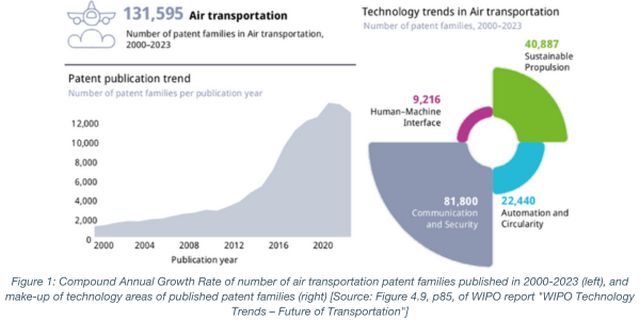
In terms of innovation areas, the report considers four key
technology areas:
- Sustainable propulsion (e.g. hydrogen fuel cells, electric
turbines); - Automation and circularity (e.g. robotics, additive
manufacture, recycling); - Communication and security (e.g. navigation, 5G,
cybersecurity); and - Human-machine interface (e.g. touch displays, facial
recognition, virtual reality).
As shown in Figure 1 above (right), communication and security
is by far the largest contributor to innovation activity, in air
transportation, of the four areas. This is unsurprising given that
communication and security includes technologies such as
navigation, connectivity and cyber security. Sustainable propulsion
follows in second place, with automation and circularity, and
human-machine interface, technologies in third and fourth place
respectively. The make-up of these four contributing technology
areas is explored in more detail in Figure 4 below.
Patent family publication trends in air transportation in
2000-2023 by inventor location
Another interesting representation provided by the report is
copied below as Figure 2. In Figure 2 the relative proportion of
innovation in the four focussed-upon technology areas is broken
down by inventor location. Various trends emerge such as, for
example, a focus of Belgian and UK innovation in the sustainable
propulsion area. Some territories are also observed to place a
significant emphasis on communication and security technologies
over and above any other technology areas, such as in China, Israel
and the Russian Federation in particular. Given other trends which
emerge, which will be explored below, a comparatively small
proportion of sustainable propulsion effort in China is a
surprising result of Figure 2.
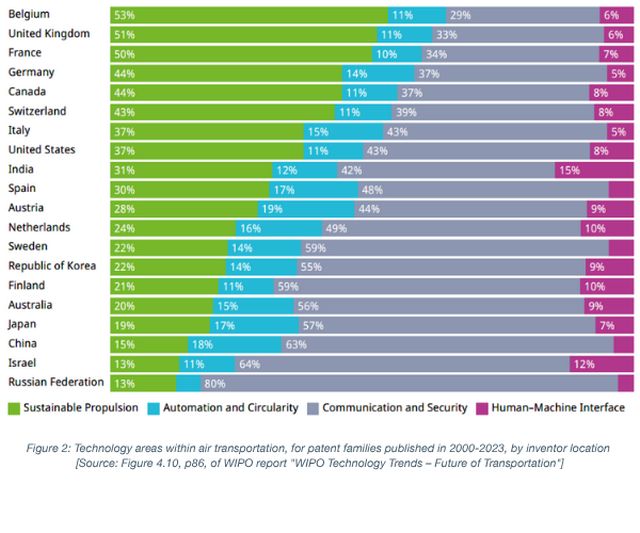
Compound Annual Growth Rate (CAGR) of patent family
publications by top 25 patent owners in air transportation in
2018-2023
Figure 3, below, illustrates significant patent filing growth
from some of the largest Chinese patent filers in the air
transportation field during the period 2018-2023. In contrast, some
of the very largest, and most renowned, businesses in the field,
such as Rolls Royce, Boeing and General Electric, have seen a
significant reduction in the CAGR of patent filings. As mentioned
previously, the aftereffects of the COVID-19 pandemic likely play a
role here, particularly for the businesses with reduced CAGR. The
growth in filings in China may be attributable to general trends in
competing aviation technologies out of China in recent years,
challenging some of the industry’s historical aviation
powerhouses.
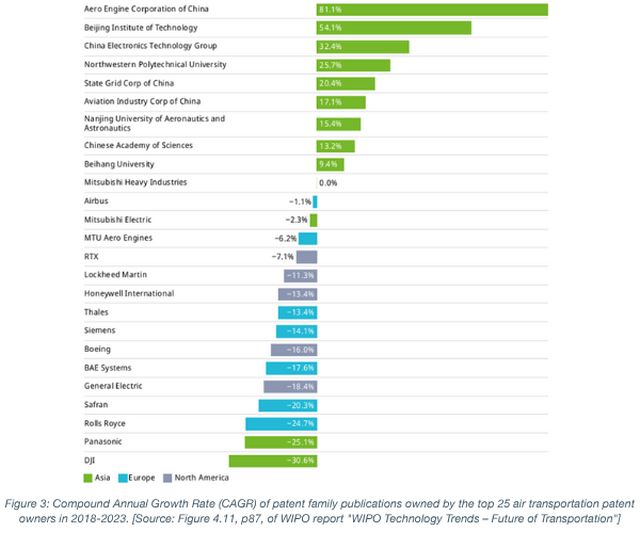
Patent landscape of air transportation patent families by
technology areas and territory in 2000-2023
Figure 4 below shows the breakdown of the four key technology
areas (communication and security, sustainable propulsion,
automation and circularity and human-machine interface) in more
detail. Stepping through each of the key areas in turn:
- Sustainable propulsion technologies (~41k total) are dominated
by efficient aircraft turbines (~27k families), with battery (~11k)
and electric propulsion technologies (~7k) providing a significant
contribution. Hydrogen fuel cells and sustainable carbon-based
fuels jointly contribute ~5k patent family publications; - Automation and circularity (~22k total) is, for the most part,
constituted by smart production technologies (~20k). Efficient
material use technologies contribute ~2k family publications, with
recycling technologies providing a (to me) surprisingly low
proportion of
- Communication and security technologies (~82k total) dominate
the overall publication numbers, with navigation providing a
significant proportion (~67k) of the overall patent families in the
field. Low-latency communications (~13k), device-to-device (~8k)
and cloud (~5k) technologies contribute significantly, also. Cyber
security is the smallest proportion of communication and security
technologies at ~1.5k publications; and - Human-machine interface (~9k total) technologies are
constituted by more of a spread of technologies including: touch
display and data gloves (~4k), VR and AR (inc XR and the metaverse)
(~3k) and facial recognition (~1.6k), and heads-up-display
technologies (1.3k).
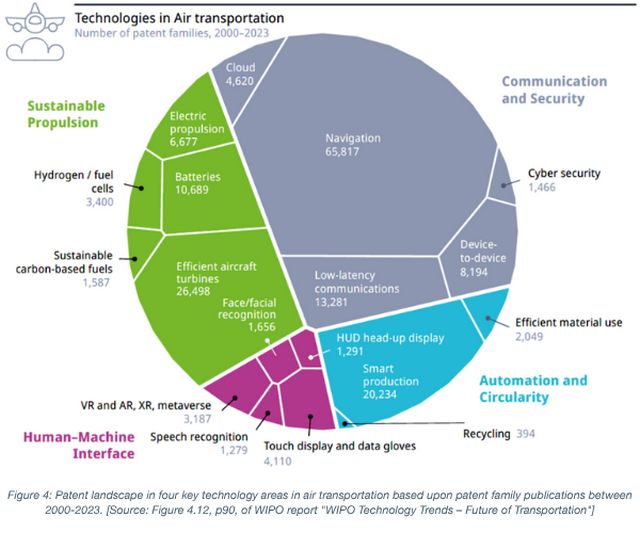
It is surprising to see quite the extent to which navigation
technologies have outpaced all other areas. I also expected cyber
security technologies may constitute a greater proportion of the
communication and security technologies. Sustainable propulsion
technologies are, altogether, lower in number than I expected,
particularly in light of the significant communication and security
contribution. Smart production constituting a significant
proportion of the automation and circularity technology area is not
entirely surprising, but the comparatively low number of recycling
patent families is a surprise. That said, there may well be overlap
between recycling and efficient material use technologies.
Figure 5 below shows a breakdown of the four key technology
areas based upon inventor location. Figure 5 thus illustrates
territories particularly active in innovation for a given area.
Other data shown in Figure 5 includes high growth (CAGR) locations
for the different technology areas, and a specialised location
index (a WIPO metric) indicating territories which are particularly
specialist in certain technology areas. Lastly, the top patent
owners in each of the different technology areas are listed.
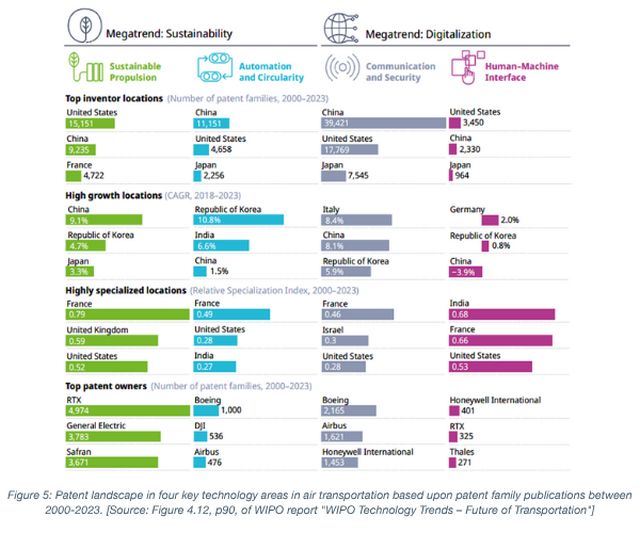
Stepping through some observations from the Figure 5 data
above:
- China and the US emerge as significant leaders for inventor
locations across the four technology areas in air transportation,
with notable mentions to France for sustainable propulsion
technologies, and Japan for automation and circularity, and
communication and security, technologies; - China emerges as a high growth location across all technology
areas, with a seeming CAGR reduction across the board for
human-machine interface technologies (given even China’s
negative CAGR). The Republic of Korea, and Italy, emerge as high
growth location leaders for automation and circularity, and
communication and security, technologies respectively; - France is a clear leader across all technology areas in terms
of specialism (‘relative specialism index [RSI])’. The RSI
is a WIPO metric indicative of a territory’s ‘share’ of
patenting activity in a particular field, taking into account the
territory’s overall level of patenting activity. As noted in
the report, given France’s significant aerospace industry
(Airbus, Safran), this result is not surprising. The UK emerges as
a significant contributor in the sustainable propulsion field, more
specialised than even the US; and - Boeing is the most prolific patenting entity in the automation
and circularity, and communication and security, fields. RTX,
formerly Raytheon Technologies Corporation, is the largest owner of
sustainable propulsion technologies patents, with General Electric
and Safran following. The numbers of sustainable propulsion
technology patents owned by the largest filers are far higher than
those of the communication and security fields, despite the number
of sustainable technology patent families being lower. This
suggests a greater spread of patent ownership for communication and
security technologies, in contrast to a more ‘concentrated’
ownership of sustainable propulsion technologies patents.
Technology focus: urban air mobility
One air transportation area which has seen significant recent
development is that of urban air mobility. That is, the use of
personal, or low capacity, aircraft in urban environments.
Figure 6 below shows the trend in (generally) increasing
publication numbers of both patent families and scientific
publications in the field during the period 2000-2023. The report
notes an increase in global patent family publications from 67 in
2014 to almost 400 in 2023. That said, these numbers remain
relatively low, perhaps indicative of caution in the field given
the significant infrastructure, regulatory and other developments
needed for the technology to become mainstream. There have also
been an unfortunate number of high profile urban air mobility firms
facing bankruptcy as of late (Lilium, Volocopter), suggesting the
field remains a commercially challenging one.
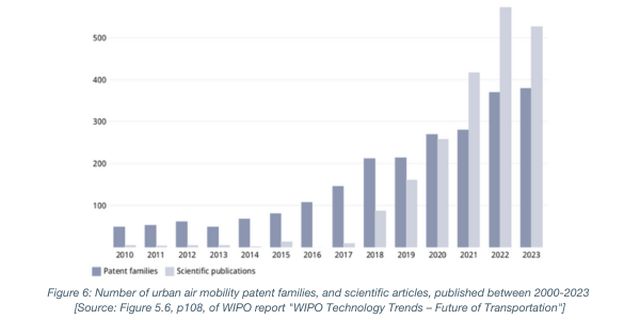
How does innovation in air transportation compare to other
transport modes?
A surprising conclusion highlighted by the report is that air
transportation, where applicants are typically prolific in the
filing of patents, places in a comfortable last position when
compared to counterpart land, sea and space transport modes. This
is specifically with regard to the four key technology areas
discussed in detail elsewhere in this article, as evidenced by the
2018-2023 patent publication data set out below in Figure 6.
As already mentioned, I expect COVID-19 has had a role to play
in the air transportation innovation trends since ~2019. It is
perhaps not surprising that significant growth has been observed in
the space sector, but the rates of growth in land and sea
technologies are a pleasant surprise. Across the board,
communication and security, and sustainable propulsion, areas rank
highly, but automation and circularity is, surprisingly, the
highest contributor for land transport modes.
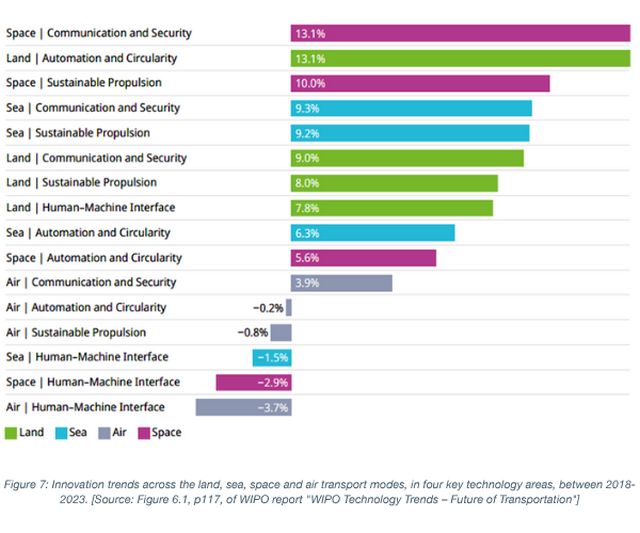
Closing remarks and predictions for the future
Whilst patent filing numbers are (generally) significantly
higher than ~10 years ago, air transportation in particular has
seen recent contractions in growth rates. This is particularly the
case for the (historically) largest patent filers in the industry,
some of whom have seen filing numbers reduced by ~25% and more.
Some of the highest growth rates are observed from Chinese
entities, as global competition continues to drive innovation.
Innovation remains to have a territorial bias, with, for
example, arguably more of a European focus for sustainable
propulsion technologies, with other regions focussing more on other
areas (such as communication and security).
The number of published patent families directed to navigation
technologies far exceeds any comparable technology area in air
transportation. The number of navigation-linked patent families
published exceeds the total number of sustainable propulsion
families in air transportation.
When inventor locations are considered, China and the US are the
most prolific territories for air transportation innovation, with a
significant contribution from France also.
My predictions for air transportation innovation? I expect
continued growth in sustainable propulsion in particular. I expect
we will continue to see the highest growth rates from Chinese
applicants. Finally, I expect continued, cautious growth around
urban air mobility (likely with continued commercial difficulties
for some firms, at least in the short term).
One thing we can be sure of? Businesses operating in the air
transportation field will continue to protect their most valuable
innovations by way of patent applications and other forms of
registered intellectual property (e.g. design registrations, trade
marks etc.).
The content of this article is intended to provide a general
guide to the subject matter. Specialist advice should be sought
about your specific circumstances.





